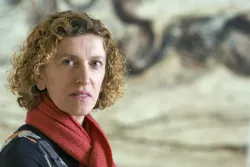2022 Chappell Public Lecture
The Research School of Earth Sciences is delighted to announce Professor Daniela Rubatto will be presenting the 2022 Chappell Public Lecture
Content navigation
RegisterDescription
The Chappell Public Lecture series is in honour of Professor Bruce Chappell, one of the most distinguished geologists of his generation who made significant scientific contributions in understanding the compositional variations and origins of granitic rocks. Chappell’s career at ANU spanned more than 30 years, from 1960 to 1997.
Date & time: 9 March 2020, 5.30–6:30pm AEST (in person and via Zoom), followed by light refreshments.
Location: Finkel Theatre, John Curtin Medical ,School 131 Garran Rd, Acton ACT 2601. This is an in-person event and will also be live streamed.
ZOOM: ID: 606 666 0101 Password: jaeger
Speaker: Professor Daniela Rubatto, University of Bern and University of Lausanne, Switzerland
About the presenter

Daniela Rubatto is a highly awarded Professor of geochemistry at the University of Bern, Switzerland. Her areas of interest and expertise are in isotope geochemistry, metamorphic petrology, mineralogy, tectonics, inorganic geochemistry, and geochronology.
In 1998 Daniela and her partner Joerg Hermann were awarded Fellowships from the Swiss National Science Foundation and moved to Australia to continue their research in Earth sciences at ANU. Here she held the positions of Postdoctoral Fellow, 1998–2002 APD-Fellow, Dep. of Geology 2002–2004, QEII Fellow 2005–2010, Associate Professor 2010–2013 and QEII Fellow, 2011–2015. In 2015 she became the first female professor at the Research School of Earth Sciences.
In 2015 she moved back to Switzerland to join the Institute of Geological Sciences at the University of Bern, and she also holds a part-time appointment as senior researcher at the Institute de Sciences de la Terre at the University of Lausanne, Switzerland.
Abstract
Aqueous fluids play a critical role during metamorphic processes in the Earth’s crust because they have first-order influence on element transport, reaction kinetics and heat transfer. Understanding their fluxes, sources and interaction with minerals is fundamental for the comprehension of these processes. How, when and where does fluid-mineral interaction take place in metamorphic rocks are basic issues that remain poorly constrained, partly because the fluids eventually escape the rock system leaving a concealed, often invisible path behind.
As fluid interaction can occur during events separated in time and under different physicochemical conditions, micro sampling of distinct minerals and mineral zones is best suited to resolve stages of fluid-rock interaction. I will present an approach that combines in situ oxygen isotope measurements in key minerals, with textural analysis, chemical zoning and modelling to address key questions concerning sources and pathways of fluids in the crust with implications for crustal evolution.
Using case studies, I will show that analyses of distinct mineral zones enable identification of multiple pulses of fluids during the rock evolution and can assist in distinguishing relative timing and sources of fluids. High fluid fluxes are not limited to shear zones and lithological boundaries but can be can be pervasive even at high-pressure conditions. Transient rock volume variations are a likely trigger for extensive fluid influx in rock units at depth. Recycling of weathered lithologies in the deep crust already occurred in the early stages of crustal formation.
Location
Finkel Theatre, John Curtin Medical School, 131 garran Road, Acton, ACT 2601
